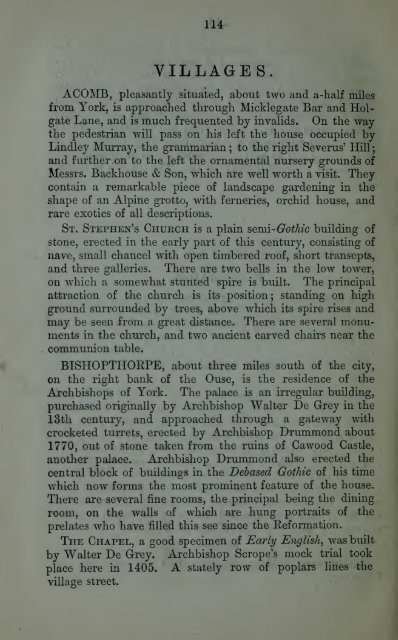practicalguideto00unse_0
Create successful ePaper yourself
Turn your PDF publications into a flip-book with our unique Google optimized e-Paper software.
114<br />
VILLAGES.<br />
AC0MB, pleasantly situated, about two and a-lialf miles<br />
from York, is approached through Micklegate Bar and Holgate<br />
Lane, and is much frequented by invalids. On the way<br />
the pedestrian will pass on his left the house occupied by<br />
Lindley Murray, the grammarian ; to the right Severus' Hill<br />
and further .on to the left the ornamental nursery grounds of<br />
Messrs. Backhouse & Son, which are well worth a visit. They<br />
contain a remarkable piece of landscape gardening in the<br />
shape of an Alpine grotto, with ferneries, orchid house, and<br />
rare exotics of all descriptions.<br />
St. Stephen's Church is a plain semi- Gothic building of<br />
stone, erected in the early part of this<br />
century, consisting of<br />
nave, small chancel with open timbered roof, short transepts,<br />
and three galleries. There are two bells in the low tower,<br />
on which a somewhat stunted spire is built. The principal<br />
attraction of the church is its position; standing on high<br />
ground surrounded by trees, above which its spire rises and<br />
may be seen from a great distance. There are several monuments<br />
in the church, and two ancient carved chairs near the<br />
communion table.<br />
BISHOPTHORPE, about three miles south of the city,<br />
on the right bank of the Ouse, is the residence of the<br />
Archbishops of York. The palace is an irregular building,<br />
purchased originally by Archbishop Walter De Grey in the<br />
13th century, and approached through a gateway with<br />
crocketed turrets, erected by Archbishop Drummond about<br />
1770, out of stone taken from the ruins of Cawood Castle,<br />
another palace. Archbishop Drummond also erected the<br />
central block of buildings in the Debased Gothic of his time<br />
which now forms the most prominent feature of the house.<br />
There are several fine rooms, the principal being the dining<br />
room, on the walls of which are hung portraits of the<br />
prelates who have filled this see since the Reformation.<br />
The Chapel, a good specimen of Early English^ was built<br />
by Walter De Grey. Archbishop Scrope's mock trial took<br />
place here in 1405. A stately row of poplars lines the<br />
village street.















